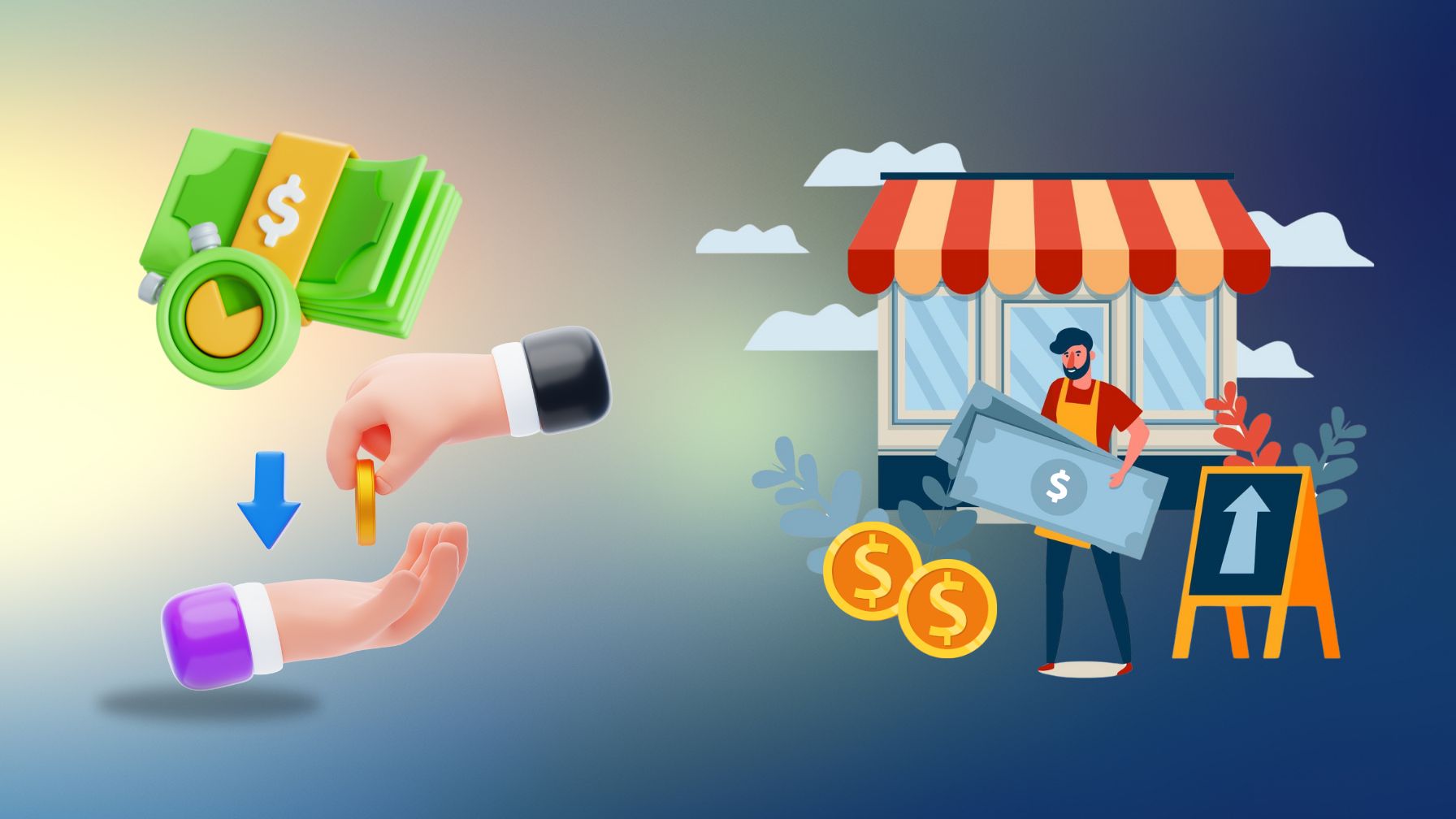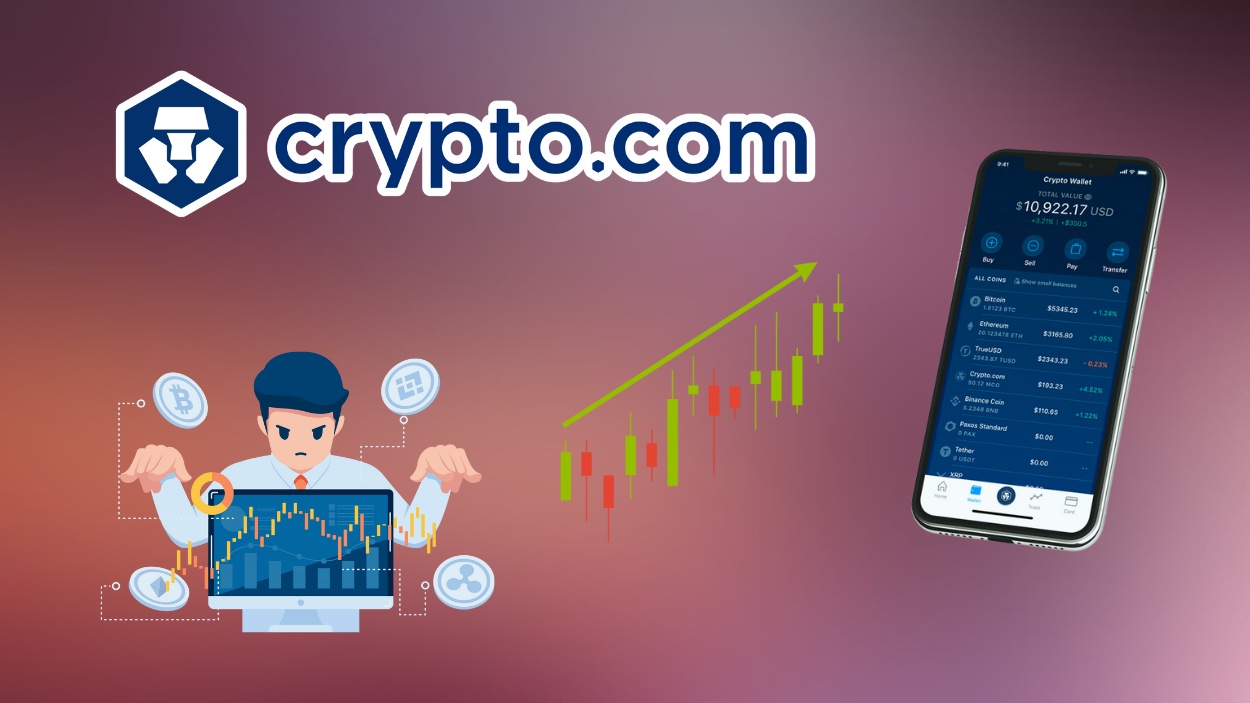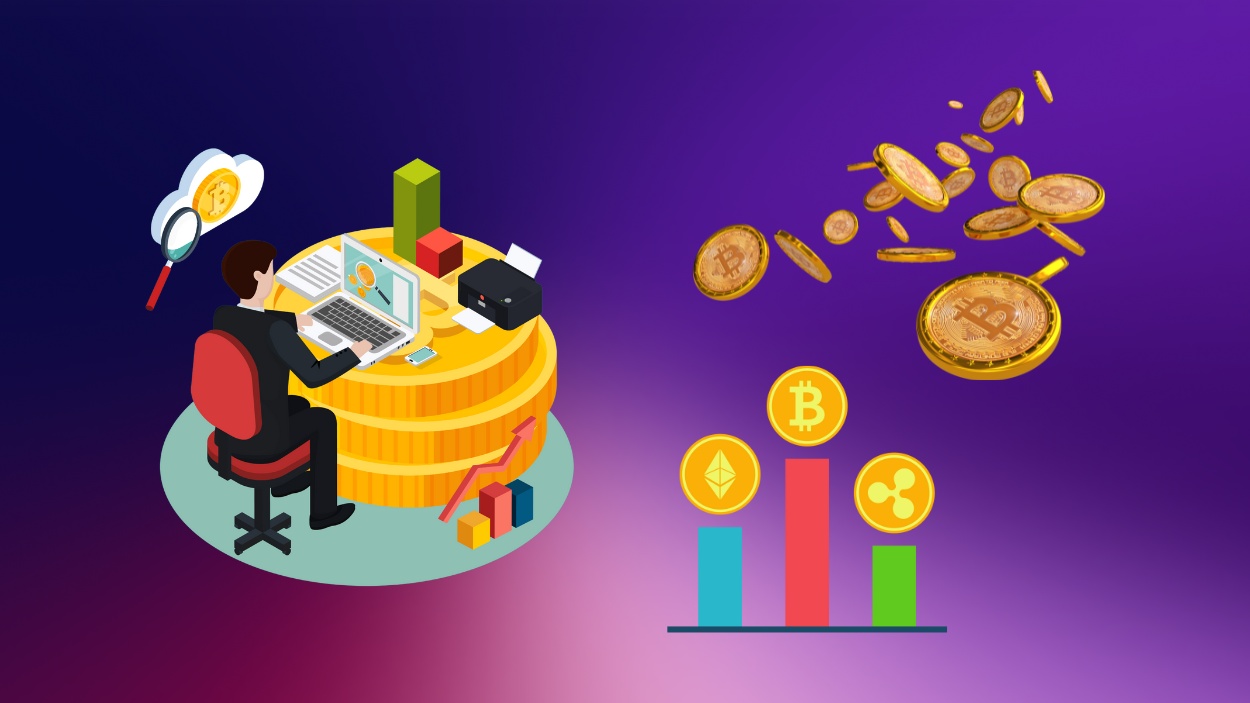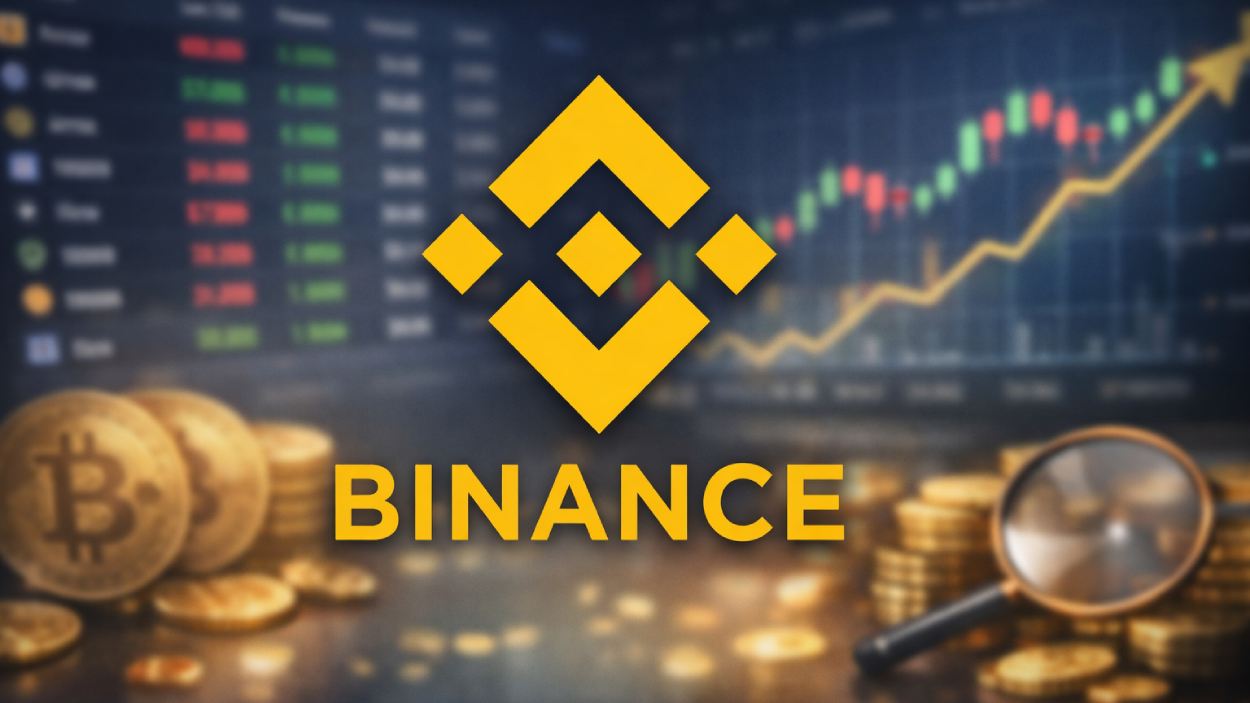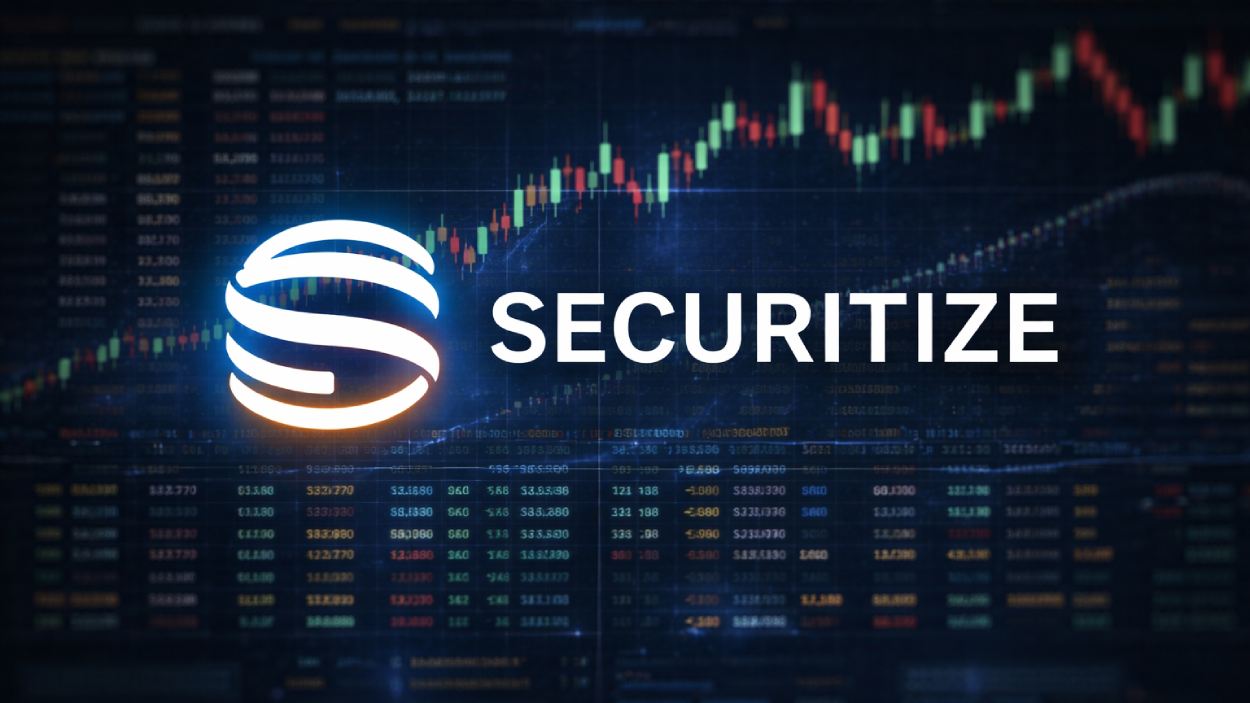Small businesses are the backbone of the economy, providing jobs, fostering innovation, and contributing to community development. Yet, one of the greatest challenges they face is securing the necessary funding to grow and thrive. Whether it’s for expansion, managing cash flow, or purchasing new equipment, small business lending is crucial. In 2025, as we navigate post-pandemic recovery and economic uncertainty, understanding the trends and statistics behind small business lending has never been more important. Let’s explore some key statistics and trends shaping small business lending this year.
Editor’s Choice: Key Lending Trends for Small Businesses
- $760 billion Estimated total lending volume to small businesses in the US for 2025.
- 54% Percentage of small business loan applications approved by small banks in 2025.
- 38% Share of small businesses relying on loans or other credit forms to meet day-to-day operational needs in 2025.
- $435,827 Average SBA loan size for small businesses in 2025, marking a 38% decrease from $704,581 in 2021.
- 32% Female-owned businesses’ share of total small business loans in 2025.
- 15% Increase in loan approvals for minority-owned businesses in 2025, signaling improvements in financial inclusivity.
- $195,000 Average outstanding small business debt in the US as of 2025, highlighting the significant role of credit in the sector.
Small Business Outstanding Debt
- 30% of small businesses reported having no outstanding debt, highlighting strong financial health for nearly one-third of businesses.
- 17% of small businesses have outstanding debts ranging from $1,000 to $25,000.
- 21% of small businesses owe between $25,000 and $100,000 in debt, making it the second-largest group after those with no debt.
- 13% of small businesses carry debts between $100,000 and $250,000.
- Another 13% of small businesses have outstanding debts in the range of $250,000 to $1 million.
- Only 6% of small businesses report debts exceeding $1 million, showing that large debts are relatively uncommon.

What is Small Business Lending?
Small business lending refers to the various forms of financing options made available to businesses that typically have fewer than 500 employees. These loans can come from a variety of sources, including banks, credit unions, and alternative lenders. Lending allows businesses to access funds for purposes such as expansion, inventory purchasing, hiring, or maintaining cash flow. Small business loans often come with specific terms that include interest rates, repayment periods, and loan covenants, which vary depending on the lender and the type of loan.
Types of Small Business Loans
- Term Loans offer fixed lump sums up to $5 million with repayment terms ranging from 1 to 10 years, featuring interest rates between 6.25% and 9%.
- SBA 7(a) Loans provide up to $5 million in funding with government-backed guarantees, offering rates from 11.5% to 15% (variable) and 13.5% to 16.5% (fixed).
- Business Lines of Credit grant flexible access to funds up to $500,000, with interest rates ranging from 3% to 39.9%, allowing businesses to draw funds as needed.
- Invoice Financing enables businesses to borrow against outstanding invoices, with factor rates between 1% and 6%, providing quick access to cash while awaiting client payments.
- Merchant Cash Advances offer immediate funds up to $5 million, repaid through a percentage of daily sales, with factor rates typically between 1.1 and 1.5.
- Equipment Financing allows for the purchase of equipment with loans up to $500,000, using the equipment itself as collateral, and repayment terms ranging from 24 to 60 months.
- Microloans provide smaller loan amounts up to $50,000, ideal for startups or very small businesses, with average loan sizes around $13,000 and interest rates between 8% and 13%.
Small Business Ownership by State (Geographic Distribution)
- California leads with 3.43 million small businesses, the highest number among all states.
- Texas follows closely, hosting 2.87 million small businesses across the state.
- Florida ranks third with 2.77 million small business firms.
- New York has 1.78 million small businesses, placing it fourth among the top states.

Small Business Loan Application
- 59% of small businesses applied for financing in 2025, indicating a decrease in capital-seeking activities.
- 51.3% of applicants received some or all of the funding they requested in 2025, reflecting tighter lending conditions.
- Banks accounted for 50% of all loan approvals, while online lenders approved 25% of loans in 2025, maintaining their positions as primary funding sources.
- $83,348 was the average amount requested by small businesses during loan applications in 2025, suggesting a trend toward smaller loan requests.
- 56% of businesses that applied for loans sought funding to cover operating expenses, with 46% seeking capital for business expansion in 2025, highlighting the primary motivations for financing.
- 45% of businesses experienced delays or complications during the loan application process in 2025, citing stricter documentation requirements as a significant hurdle.
- 77% of small business loan applications were completed online in 2025, demonstrating continued growth in digital banking adoption.
Top Reasons Small Businesses Apply for Loans
- 45% of small businesses apply for loans primarily for business expansion.
- 30% of small business loan applications are intended for equipment purchases.
- 25% of small businesses seek loans for marketing and advertising efforts.
- 25% of applicants pursue loans to support business franchising.
- 25% of small business loans are directed toward commercial real estate purchases or remodeling.
- 20% of businesses apply for loans to finance business acquisitions.
- 20% of small businesses take loans for inventory purchases.
- 20% of businesses seek loans to maintain cash flow for everyday operations.
- 15% of loans are used to cover payroll expenses.
- 15% of businesses apply for debt consolidation or refinancing.
- 15% of small businesses take loans to cover startup costs.
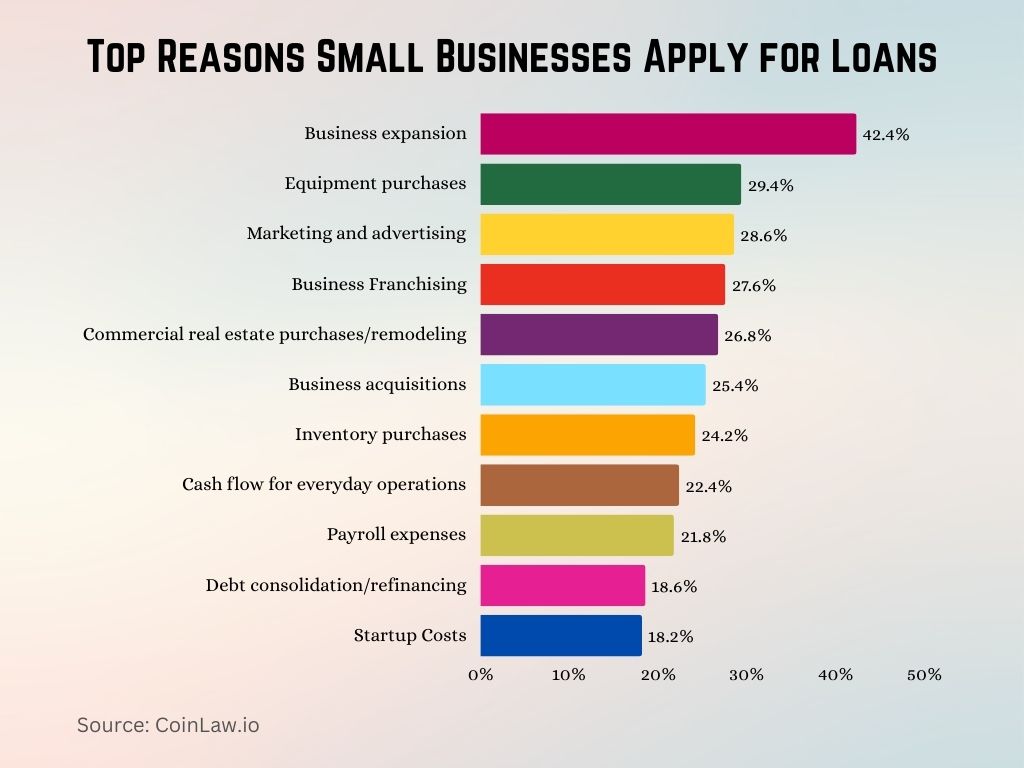
Percentage of Businesses That Had Their Loans Denied
- 24% of small businesses had their loan applications denied in 2025, consistent with the previous year.
- Businesses with annual revenues below $100,000 faced a denial rate of 35%, compared to 18% for those with revenues over $1 million.
- 50% of startups (less than 2 years old) were denied funding in 2025, highlighting ongoing challenges for new businesses.
- 40% of retail sector businesses reported loan denials in 2025, among the highest across industries due to higher risk perception.
- The top reasons for loan denials included poor credit history (35%) and insufficient collateral (25%).
- 20% of minority-owned businesses experienced loan denials in 2025, a decrease from 30% in 2022, reflecting gradual progress in addressing lending inequality.
- 15% of businesses with existing loans were denied additional funding in 2025 due to high debt levels.
Average Credit Score for Loan Applications
- 680 is the average credit score required for a small business loan in 2025, reflecting stable lending standards.
- SBA 7(a) loans typically require a personal credit score of 680 or higher, with some lenders considering scores as low as 650, depending on other financial factors.
- Businesses with credit scores between 620 and 660 have approximately a 50% chance of securing financing, contingent upon additional factors like revenue and collateral.
- 75% of loan applicants with credit scores above 720 were approved for loans in 2025, indicating strong approval rates for high-credit applicants.
- 20% of businesses with credit scores below 600 were approved, often through alternative lenders offering higher interest rates to offset risk.
- Credit score trends in 2025 show that businesses in the technology sector tend to have higher average scores, around 710, compared to 620 in the hospitality industry, highlighting sector-based credit disparities.
- 50% of small business owners actively worked to improve their credit score before applying for loans, employing strategies such as paying down debt and correcting errors on their credit reports.
Common Reasons for Funding
- 30% of small businesses applied for loans to cover operating expenses like rent and payroll
- 25% of businesses sought loans for expansion purposes, such as new locations or product lines
- 11% of applicants aimed to refinance existing debt
- 10% applied for loans to purchase equipment and improve operations
- 18% needed funding for working capital reserves for emergencies
- 4% of applications came from startups seeking capital for inventory and launch
- 2% sought funding for marketing and advertising, especially for digital growth
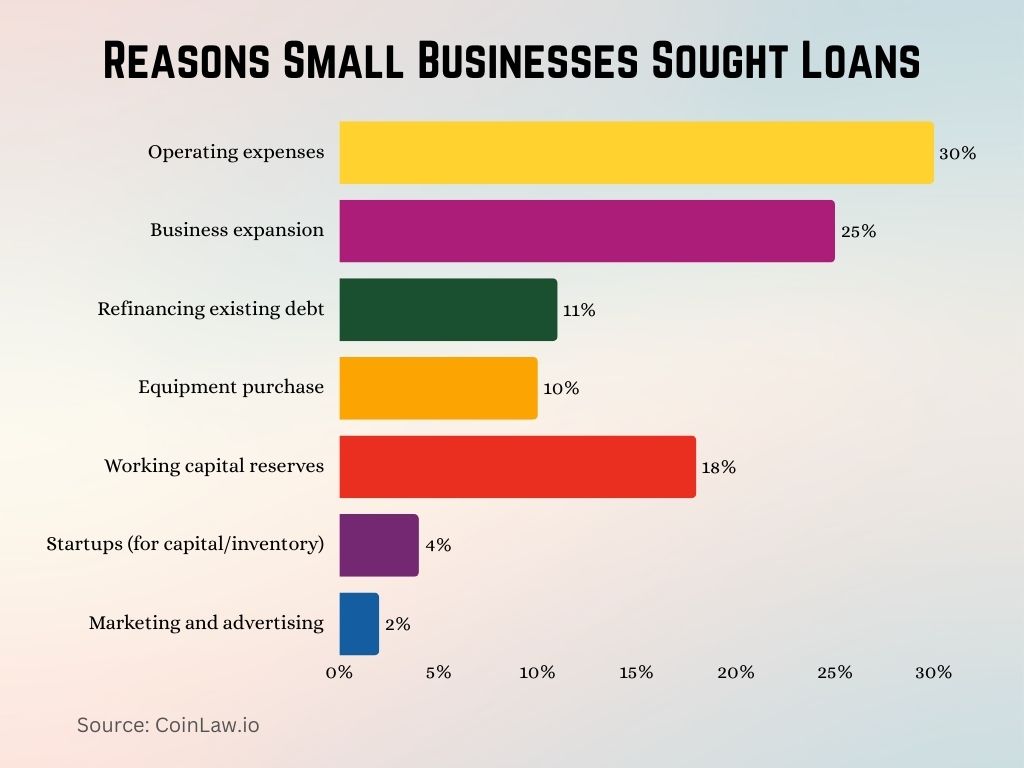
Small Business Loans by Region
- 30% of all small business loans in 2025 were issued in California, Texas, and Florida, reflecting their substantial economic activity.
- 72% loan approval rate for businesses in the Northeast US, compared to 65% in the Midwest and 60% in the South.
- 80% loan approval rate for businesses in urban centers like New York City and Los Angeles, while rural businesses had a lower approval rate of 55%.
- 12% increase in small business lending in the Pacific Northwest in 2025, driven by growth in technology and green energy sectors.
- 8% rise in loan applications in Southern states, particularly Georgia and North Carolina, as businesses sought capital for economic recovery.
- 40% of loan applications from rural businesses were denied in 2025, highlighting ongoing challenges due to limited lender access and stricter requirements.
- 50% of loans in Midwestern states were approved by community banks, underscoring their critical role in regional small business support.
Small Business Loans by Lenders
- Banks remain the primary source, accounting for 45% of all approved small business loans in 2025, offering competitive interest rates ranging from 6.57% to 11.7%.
- Credit Unions approved 15% of small business loans, often providing lower interest rates and personalized services compared to traditional banks.
- Online Lenders have increased their market share, accounting for 30% of all small business loans in 2025, offering rapid funding solutions.
- Community Banks approved 20% of loans, focusing on local businesses and entrepreneurs, and playing a critical role in regional economic development.
- SBA-backed Loans saw a 7% increase in applications in 2025, attributed to attractive interest rates and longer repayment periods.
- Microloans, typically provided by nonprofit lenders, accounted for 5% of the lending market, with the average loan size being $13,500.
- Peer-to-Peer (P2P) Lending Platforms provided 10% of small business loans, offering alternative financing options for businesses that may face challenges with traditional lenders.
Small Business Loans by Industry
- 32% of small business loans went to service-based industries like healthcare and education due to steady demand and lower risk
- 20% of loans were issued to retail businesses, though often at higher interest rates due to volatility
- 12% of loan approvals went to the construction industry, driven by infrastructure and real estate growth
- 10% of loans supported manufacturing businesses, primarily for technology and machinery upgrades
- 16% of loan approvals went to technology startups and IT firms, reflecting strong innovation and sector growth
- 8% of loans were approved for hospitality and tourism, still recovering from prior disruptions
- 2% of loans supported agricultural businesses, with a focus on sustainable farming and expansion
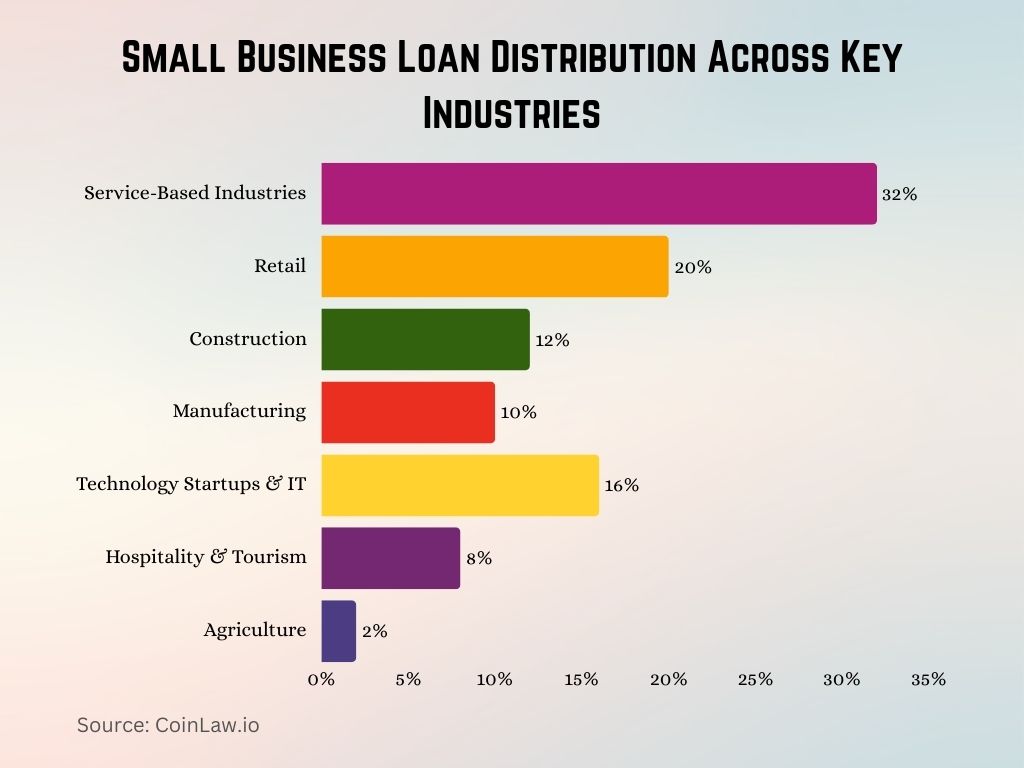
Percentage of Businesses With Outstanding Debt
- 71% of small businesses carry outstanding debt in 2025, a slight decrease from previous years.
- 39% of businesses report holding more than $100,000 in debt, maintaining levels higher than pre-pandemic years.
- 32% of businesses have less than or equal to $100,000 in debt, indicating a significant portion managing smaller debt loads.
- The average small business debt is approximately $195,000, reflecting the financial burdens many businesses carry.
- 25% of businesses face challenges in meeting their debt obligations, leading to increased reliance on revolving lines of credit.
- The default rate for small business loans is projected to decline to 3.19% in 2025, indicating improved financial stability.
- Construction and manufacturing industries are most likely to carry high levels of debt due to the capital-intensive nature of their operations.
Average Interest Rates
- 6.54% to 11.7% is the average interest rate range for small business loans from banks in 2025, depending on loan type and borrower qualifications.
- 12.5% to 15.5% are the fixed interest rates for SBA 7(a) loans in 2025, varying by loan amount.
- 10.5% to 14.0% are the variable interest rates for SBA 7(a) loans in 2025, depending on the loan amount.
- 7.38% is the median interest rate for fixed-term business loans in 2025.
- 7.84% is the median interest rate for variable-term business loans in 2025.
- 8% to 13% is the typical interest rate range for SBA microloans in 2025.
- Starting at 7.00% are the interest rates for equipment financing loans from Bank of America in 2025.
- 10% is the starting interest rate for short-term business loans in 2025.
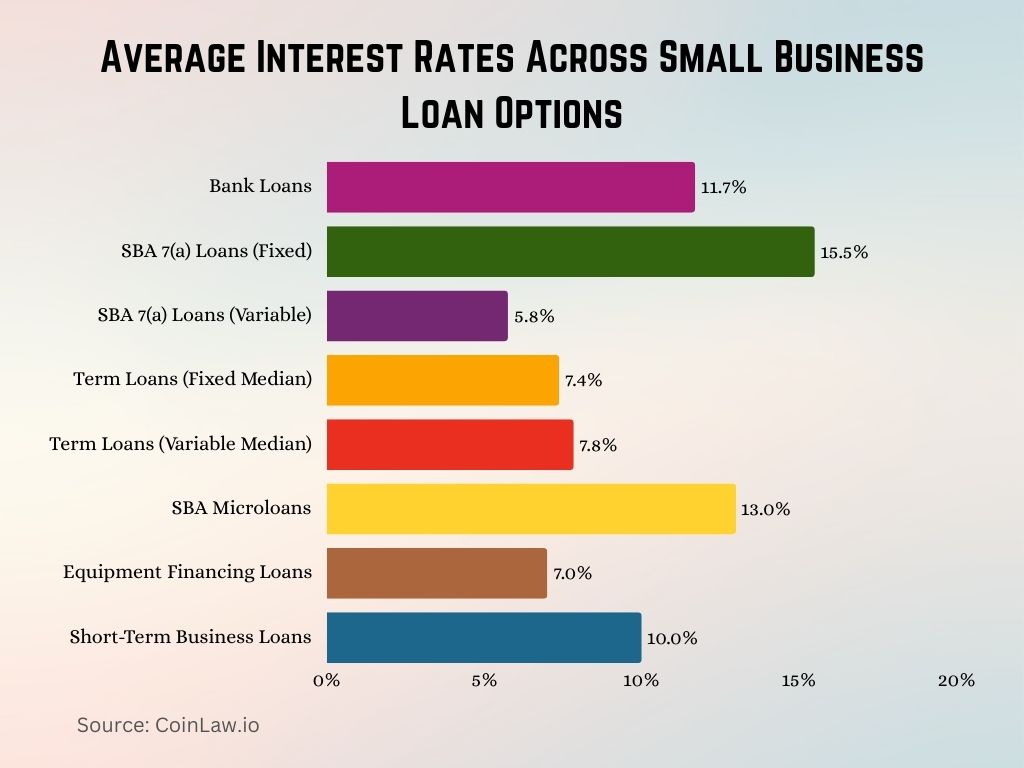
Impact of Small Business Loans on the Economy
- $1.4 trillion is the estimated total small business loan market in 2025, with small businesses contributing over 43% to the U.S. GDP.
- 98.5% of net job gains in Q2 2022 were attributed to small businesses, highlighting their pivotal role in employment growth.
- 74% increase in SBA 7(a) loan approvals for small manufacturers in early 2025 compared to the same period in 2021, indicating robust support for the manufacturing sector.
- 60% of new SBA loans in the first 100 days of 2025 benefited businesses with five or fewer employees, emphasizing support for the smallest job creators.
- $500 billion in private credit has been invested in over 3,600 businesses, supporting an estimated 1.6 million jobs and contributing $224 billion to the GDP.
- $137 billion in wages and benefits were generated through private credit investments, underscoring the sector’s significant economic impact.
- 43% of the U.S. GDP is attributed to small businesses, reflecting their substantial contribution to the national economy.
Recent Developments in Small Business Lending
- 18% of small businesses utilize digital lending platforms in 2025, indicating significant growth in fintech adoption.
- Blockchain technology is increasingly adopted by lenders to enhance transaction security and reduce fraud in small business lending.
- New regulations have improved transparency in lending, requiring online lenders to disclose interest rates and fees more clearly.
- $5 billion in green financing options have been issued to small businesses focusing on sustainable practices, reflecting a growing emphasis on environmental responsibility.
- 65% of small businesses report using AI-powered tools for loan processing in 2025, streamlining credit assessments and approvals.
- $24 billion in loans have been issued by Community Development Financial Institutions (CDFIs) to underserved communities, highlighting their expanding role in equitable lending.
- Cryptocurrency-backed loans are now offered by fintech firms, allowing small businesses to leverage digital assets for financing, with platforms like Arch Lending and Ledn leading the way.
Conclusion
Small business lending in 2025 presents both opportunities and challenges. As businesses navigate economic recovery, access to capital remains critical for growth, innovation, and survival. With advancements in technology, greater inclusivity, and more flexible lending options, small businesses have more avenues than ever to secure the funding they need. However, navigating this landscape requires careful planning, strong credit profiles, and an understanding of the various lending options available.
Hover or focus to see the definition of the term.


